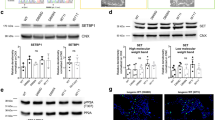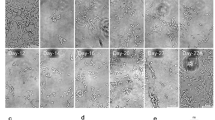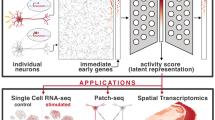Abstract
Identification of AP-1 target genes in apoptosis and differentiation has proved elusive. Secretogranin II (SgII) is a protein widely distributed in nervous and endocrine tissues, and abundant in neuroendocrine granules. We addressed whether SgII is regulated by AP-1, and if SgII is involved in neuronal differentiation or the cellular response to nitrosative stress. Nitric oxide (NO) upregulated sgII mRNA dependent on a cyclic AMP response element (CRE) in the sgII promoter, and NO stimulated SgII protein secretion in neuroblastoma cells. Upregulation of sgII mRNA, sgII CRE-driven gene expression and SgII protein synthesis/export were attenuated in cells transformed with dominant-negative c-Jun (TAM67), which became sensitized to NO-induced apoptosis and failed to undergo nerve growth factor-dependent neuronal differentiation. Stable transformation of TAM67 cells with sgII restored neuronal differentiation and resistance to NO. RNAi knockdown of sgII in cells expressing functional c-Jun abolished neuronal differentiation and rendered the cells sensitive to NO-induced apoptosis. Therefore, SgII represents a key AP-1-regulated protein that counteracts NO toxicity and mediates neuronal differentiation of neuroblastoma cells.
Similar content being viewed by others
Log in or create a free account to read this content
Gain free access to this article, as well as selected content from this journal and more on nature.com
or
Abbreviations
- CgA:
-
chromogranin A
- CgB:
-
chromogranin B
- CRE:
-
cyclic AMP response element
- DETA-NO:
-
diethylenetriamine nitric oxide adduct
- FSK:
-
forskolin
- LDH:
-
lactate dehydrogenase
- NCAM140:
-
neural cell adhesion molecule 140
- NGF:
-
nerve growth factor
- NO:
-
nitric oxide
- SgII:
-
secretogranin II
- SgV:
-
secretogranin V
- SN:
-
secretoneurin
- TRE:
-
TPA (12-O-tetradecanoylphorbol-13-acetate) response element
References
Karin M, Liu Z, Zandi E . AP-1 function and regulation. Curr Opin Cell Biol 1997; 9: 240–246.
Shaulian E, Karin M . AP-1 as a regulator of cell life and death. Nat Cell Biol 2002; 4: E131–E136.
Angel P, Karin M . The role of Jun, Fos and the AP-1 complex in cell-proliferation and transformation. Biochim Biophys Acta 1991; 1072: 129–157.
Shaulian E, Karin M . AP-1 in cell proliferation and survival. Oncogene 2001; 20: 2390–2400.
Herdegen T, Skene P, Bahr M . The c-Jun transcription factor – bipotential mediator of neuronal death, survival and regeneration. Trends Neurosci 1997; 20: 227–231.
Ait-Ali D, Turquier V, Grumolato L, Yon L, Jourdain M, Alexandre D et al. The proinflammatory cytokines tumor necrosis factor-alpha and interleukin-1 stimulate neuropeptide gene transcription and secretion in adrenochromaffin cells via activation of extracellularly regulated kinase 1/2 and p38 protein kinases, and activator protein-1 transcription factors. Mol Endocrinol 2004; 18: 1721–1739.
Desmoucelles C, Vaudry H, Eiden LE, Anouar Y . Synergistic action of upstream elements and a promoter-proximal CRE is required for neuroendocrine cell-specific expression and second-messenger regulation of the gene encoding the human secretory protein secretogranin II. Mol Cell Endocrinol 1999; 157: 55–66.
Mahata SK, Mahata M, Livsey CV, Gerdes HH, Huttner WB, O′Connor DT . Neuroendocrine cell type-specific and inducible expression of the secretogranin II gene: crucial role of cyclic adenosine monophosphate and serum response elements. Endocrinology 1999; 140: 739–749.
Turquier V, Yon L, Grumolato L, Alexandre D, Fournier A, Vaudry H et al. Pituitary adenylate cyclase-activating polypeptide stimulates secretoneurin release and secretogranin II gene transcription in bovine adrenochromaffin cells through multiple signaling pathways and increased binding of pre-existing activator protein-1-like transcription factors. Mol Pharmacol 2001; 60: 42–52.
Mahata SK, Mahapatra NR, Mahata M, O′Connor DT . Neuroendocrine cell type-specific and inducible expression of chromogranin/secretogranin genes: crucial promoter motifs. Ann NY Acad Sci 2002; 971: 27–38.
Fischer-Colbrie R, Laslop A, Kirchmair R . Secretogranin II: molecular properties, regulation of biosynthesis and processing to the neuropeptide secretoneurin. Prog Neurobiol 1995; 46: 49–70.
Taupenot L, Harper KL, O'Connor DT . The chromogranin–secretogranin family. N Engl J Med 2003; 348: 1134–1149.
Wiedermann CJ . Secretoneurin: a functional neuropeptide in health and disease. Peptides 2000; 21: 1289–1298.
Scammell JG, Reddy S, Valentine DL, Coker TN, Nikolopoulos SN, Ross RA . Isolation and characterization of the human secretogranin II gene promoter. Brain Res Mol Brain Res 2000; 75: 8–15.
Feng Z, Li L, Ng PY, Porter AG . Neuronal differentiation and protection from nitric oxide-induced apoptosis require c-Jun-dependent expression of NCAM140. Mol Cell Biol 2002; 22: 5357–5366.
Leppa S, Saffrich R, Ansorge W, Bohmann D . Differential regulation of c-Jun by ERK and JNK during PC12 cell differentiation. EMBO J 1998; 17: 4404–4413.
Feng Z, Porter AG . NF-kappaB/Rel proteins are required for neuronal differentiation of SH-SY5Y neuroblastoma cells. J Biol Chem 1999; 274: 30341–30344.
Raguenez G, Desire L, Lantrua V, Courtois Y . BCL-2 is upregulated in human SH-SY5Y neuroblastoma cells differentiated by overexpression of fibroblast growth factor 1. Biochem Biophys Res Commun 1999; 258: 745–751.
Eom DS, Choi WS, Oh YJ . Bcl-2 enhances neurite extension via activation of c-Jun N-terminal kinase. Biochem Biophys Res Commun 2004; 314: 377–381.
Hilton M, Middleton G, Davies AM . Bcl-2 influences axonal growth rate in embryonic sensory neurons. Curr Biol 1997; 7: 798–800.
Berendji D, Kolb-Bachofen V, Meyer KL, Grapenthin O, Weber H, Wahn V et al. Nitric oxide mediates intracytoplasmic and intranuclear zinc release. FEBS Lett 1997; 405: 37–41.
Lam CF, van Heerden PV, Ilett KF, Caterina P, Filion P . Two aerosolized nitric oxide adducts as selective pulmonary vasodilators for acute pulmonary hypertension. Chest 2003; 123: 869–874.
Hanson SR, Hutsell TC, Keefer LK, Mooradian DL, Smith DJ . Nitric oxide donors: a continuing opportunity in drug design. Adv Pharmacol 1995; 34: 383–398.
Dukelow AM, Weicker S, Karachi TA, Razavi HM, McCormack DG, Joseph MG et al. Effects of nebulized diethylenetetraamine-NONOate in a mouse model of acute Pseudomonas aeruginosa pneumonia. Chest 2002; 122: 2127–2136.
Lam CF, Caterina P, Filion P, Ilett KF, van Heerden PV . The safety of aerosolized diethylenetriamine nitric oxide adduct after single-dose administration to anesthetized piglets and multiple-dose administration to conscious rats. Toxicol Appl Pharmacol 2003; 190: 65–71.
Chiang LW, Grenier JM, Ettwiller L, Jenkins LP, Ficenec D, Martin J et al. An orchestrated gene expression component of neuronal programmed cell death revealed by cDNA array analysis. Proc Natl Acad Sci USA 2001; 98: 2814–2819.
Li J, Lee JM, Johnson JA . Microarray analysis reveals an antioxidant responsive element-driven gene set involved in conferring protection from an oxidative stress-induced apoptosis in IMR-32 cells. J Biol Chem 2002; 277: 388–394.
Bauer RA, Khera RS, Lieber JL, Angleson JK . Recycling of intact dense core vesicles in neurites of NGF-treated PC12 cells. FEBS Lett 2004; 571: 107–111.
Dhakshinamoorthy S, Porter AG . Nitric oxide-induced transcriptional up-regulation of protective genes by Nrf2 via the antioxidant response element counteracts apoptosis of neuroblastoma cells. J Biol Chem 2004; 279: 20096–20107.
Dhakshinamoorthy S, Sridharan SR, Li L, Ng PY, Boxer LM, Porter AG . Protein/DNA arrays identify nitric oxide-regulated cis-element and trans-factor activities some of which govern neuroblastoma cell viability. Nucleic Acids Res 2007; 35: 5439–5451.
Laslop A, Tschernitz C . Effects of nerve growth factor on the biosynthesis of chromogranin A and B, secretogranin II and carboxypeptidase H in rat PC12 cells. Neuroscience 1992; 49: 443–450.
Weiler R, Meyerson G, Fischer-Colbrie R, Laslop A, Pahlman S, Floor E et al. Divergent changes of chromogranin A/secretogranin II levels in differentiating human neuroblastoma cells. FEBS Lett 1990; 265: 27–29.
Giudici AM, Sher E, Pelagi M, Clementi F, Zanini A . Immunolocalization of secretogranin II, chromogranin A, and chromogranin B in differentiating human neuroblastoma cells. Eur J Cell Biol 1992; 58: 383–389.
Hagn C, Klein RL, Fischer-Colbrie R, Douglas BH, Winkler H . An immunological characterization of five common antigens of chromaffin granules and of large dense-cored vesicles of sympathetic nerve. Neurosci Lett 1986; 67: 295–300.
Weiler R, Marksteiner J, Bellmann R, Wohlfarter T, Schober M, Fischer-Colbrie R et al. Chromogranins in rat brain: characterization, topographical distribution and regulation of synthesis. Brain Res 1990; 532: 87–94.
Hentze H, Lin XY, Choi MS, Porter AG . Critical role for cathepsin B in mediating caspase-1-dependent interleukin-18 maturation and caspase-1-independent necrosis triggered by the microbial toxin nigericin. Cell Death Differ 2003; 10: 956–968.
Shiba D, Shimamoto N . Attenuation of endogenous oxidative stress-induced cell death by cytochrome P450 inhibitors in primary cultures of rat hepatocytes. Free Radic Biol Med 1999; 27: 1019–1026.
Jensen LM, Zhang Y, Shooter EM . Steady-state polypeptide modulations associated with nerve growth factor (NGF)-induced terminal differentiation and NGF deprivation-induced apoptosis in human neuroblastoma cells. J Biol Chem 1992; 267: 19325–19333.
Acknowledgements
We thank Zhiwei Feng for much advice and many discussions, and Saravanakumar Dhakshinamoorthy for comments on the manuscript. AGP is an adjunct staff member of The Department of Surgery, National University of Singapore. This study was supported by the Biomedical Research Council of A*STAR (Agency for Science, Technology and Research), Singapore.
Author information
Authors and Affiliations
Corresponding author
Additional information
Edited by LA Greene
Supplementary Information accompanies the paper on Cell Death and Differentiation website (http://www.nature.com/cdd)
Rights and permissions
About this article
Cite this article
Li, L., Hung, A. & Porter, A. Secretogranin II: a key AP-1-regulated protein that mediates neuronal differentiation and protection from nitric oxide-induced apoptosis of neuroblastoma cells. Cell Death Differ 15, 879–888 (2008). https://doi.org/10.1038/cdd.2008.8
Received:
Revised:
Accepted:
Published:
Issue date:
DOI: https://doi.org/10.1038/cdd.2008.8
Keywords
This article is cited by
-
Quantitative proteomics and in-cell cross-linking reveal cellular reorganisation during early neuronal differentiation of SH-SY5Y cells
Communications Biology (2022)
-
Botanical Drug Puerarin Attenuates 6-Hydroxydopamine (6-OHDA)-Induced Neurotoxicity via Upregulating Mitochondrial Enzyme Arginase-2
Molecular Neurobiology (2016)
-
A New Experimental Model for Neuronal and Glial Differentiation Using Stem Cells Derived from Human Exfoliated Deciduous Teeth
Journal of Molecular Neuroscience (2013)
-
k-Nearest neighbor models for microarray gene expression analysis and clinical outcome prediction
The Pharmacogenomics Journal (2010)
-
Upregulation of CRABP1 in human neuroblastoma cells overproducing the Alzheimer-typical Aβ42reduces their differentiation potential
BMC Medicine (2008)



